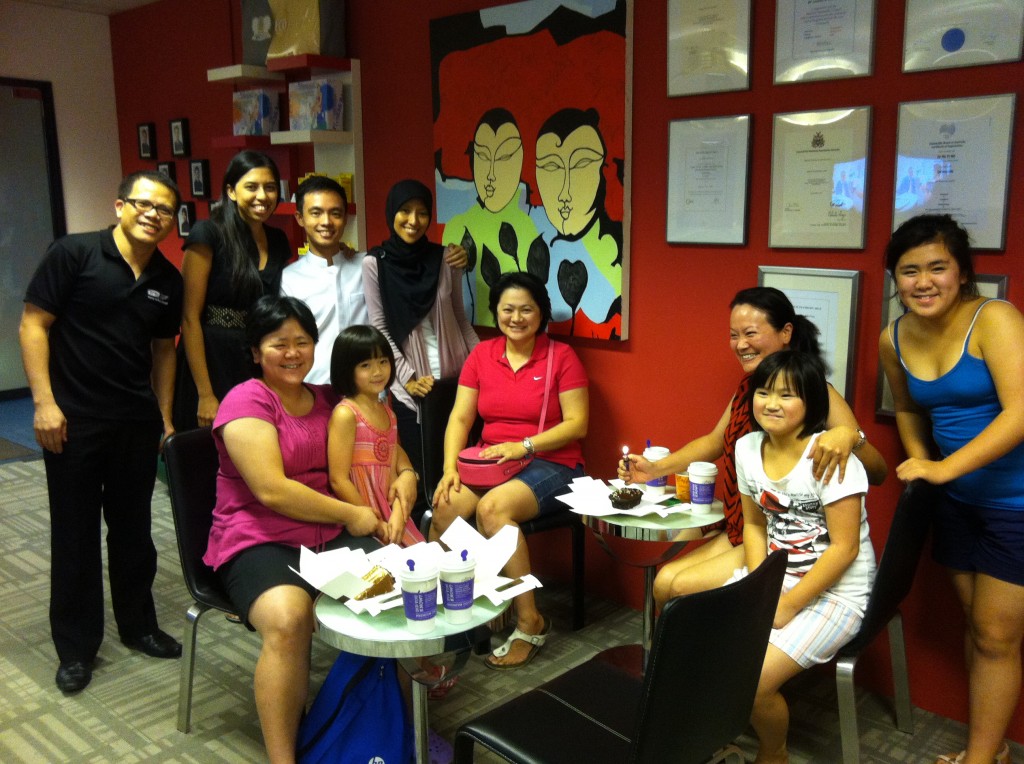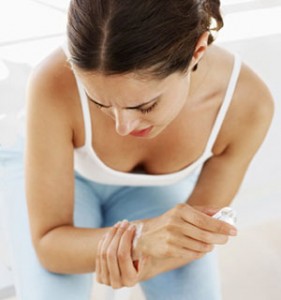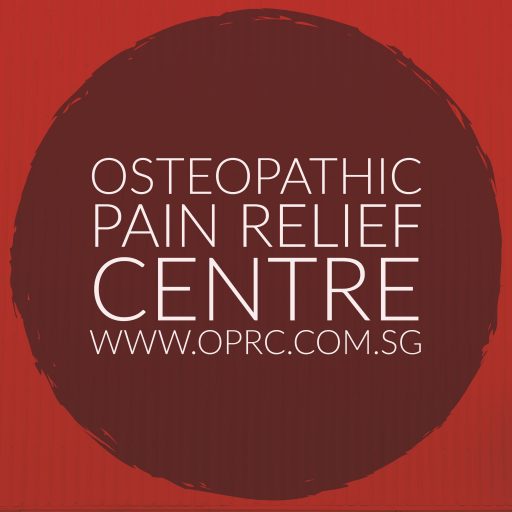by Osteopathic Pain Relief Centre | Jan 24, 2013
Susie Oh and her family seen here celebrating her cake and coffee. She has been a long supporter of OPRC as a patient and more importantly as a friend to us at the clinic. Many thanks for referring your friends & family and hope they felt relief after visiting us.

Susie Oh with sisters Patsy & Jenny, Jenny's kids- OPRC staff
Check out www.ohdeli.com.sg Oh Deli is the passionate creation of the Oh sisters, Annie, Patsy, Jenny and Susie, who are enthusiastic foodies. 421 East Coast Road.

oh sisters from www.ohdeli.com.sg
by Osteopathic Pain Relief Centre | Jan 13, 2013
Wrist injuries are common in yoga and pilates practise and osteopaths can relieve them easily.
Cause of injury:
Most people develop wrist injuries after doing too much ie more clases than normal or overloading the tissues – placing additional weight during poses. Usually people are eager to do more after the holidays or do additional classes following travel or sickness. For some they are misaligned during the pose because they are compensating for other minor injuries. Most people will delay their treatment until they can no longer practice yoga/pilates. By this time there is more swelling and compression of their joints, forced to stop yoga/pilates they seek urgent help. Important advice: seek osteopathic treatment as early as possible to recover faster.
Example of an injury
A patient recently strained her wrist because of a cut in her finger, in trying to avoid pressure on her finger she compressed her outer wrist joints by shifting her weight. She waited so long that both her wrists are giving her pain. Though she hates the idea of taking time off her classes, she reluctantly understands that she has to wait until the pain is resolved.
The forearm tissues maybe the cause-
Commonly it is not your wrist that is the main problem, the stiffness in the tissues of the forearm not allowing pronation (palm facing down) at the wrist is the underlying problem. The reduced pronation causes misalignment at the wrist bones causing compression leading to swelling in the joints.The misalignment also strains the tendons giving weakness when gripping and carrying things.
Phase 1 of treatment- to reduce your pain
Our first aim is to reduce the local pain at the wrist with gentle osteopathic manipulation, ice compress, easing the stress in the joints and releasing the tendon inflammation. Trigger point therapy maybe applied to quicken the recovery process.
Phase 2 of treatment- reduce recurrences
Usually after 2-3 osteopathic treatment sessions, the wrist pain should be better and the forearm tissues would have been released. Pronation of wrist should be easier and putting weight on your wrist into a downward dog pose or plank causes less pain. Phase 2 is about stretching and alignment education to reduce recurrence. We are keen for you to go back to your yoga/pilates as soon as possible and with greater care, you can continue your practise pain free.
Phase 3 of treatment- stay well
The final phase of treatment is a 6 monthly check up to make sure old habits don’t creep back in again. We like to promote the phrase “prevention is better than cure”.
Call 6327 8545 to enjoy a pain free yoga/pilates session.
by Osteopathic Pain Relief Centre | Jan 8, 2013
I was observing a jiu-jitsu class last night and was considering the types of injuries that might be common to each student. The class was split into three parts: warm up, learning of new techniques and sparring.
The warm up class involved light  cardio exercises followed by floor exercises mimicking movements they do during sparring.
cardio exercises followed by floor exercises mimicking movements they do during sparring.
During the learning of new techniques – students were taught new moves and ample time was given to practise through repetition.
Sparring section consisted of pairing up to practise all of what they have learnt and get a chance to incorporate the new techniques.
Here are some possible areas of injuries and advice on managing them.
 FLEXIBILITY of your muscles and joints are very important.
FLEXIBILITY of your muscles and joints are very important.
MUSCLE STAMINA is more important than brute strength. Holding down your oponent gives you more an advantage.
JOINT FLEXIBILITY is absolutely essential in getting your self out of locks as well as out manouvering your oponent into submission.
From what I have seen, i believe that students need to do therapeutic stretching to major muscle groups such as the calf, hamstrings, latissimus dorsi, trapezius, biceps, triceps. These stretches are special because you would need to sustain a stretch for at least 30 secs and repeatedly until you have achieved greater muscle length. This cannot be done during the warm up session, you just don’t have the time. In any case, these therapeutic stretches weaken your muscles because they need time to heal, that is why they are done in the days you are not training with your teacher.
You won’t be able to stretch all your muscles, so you will need deep sports massage to help you reach deeper muscles and as long as you stay relaxed during the stretches done by the therapist, your nervous system can switch off and allow a deeper stretch to occur.
In addition at OPRC, the osteopaths can use trigger point therapy to relax stubborn muscles giving you a faster way to get flexible. FASCIAL stretches are also important to get global change in your tissues.
Men have typically more shortened muscles than women, though there are exceptions. Clinical experience tells us that a combination of sports massage, osteopathic treatment together with your own stretching routines will give you a more satisfying feeling of greater muscle flexbility during your training.
Learning new techniques are hard enough- don’t let your muscle inflexibility be your weakness- let oprc help you enjoy your sport. Call 6327 8545 for your assesment.







